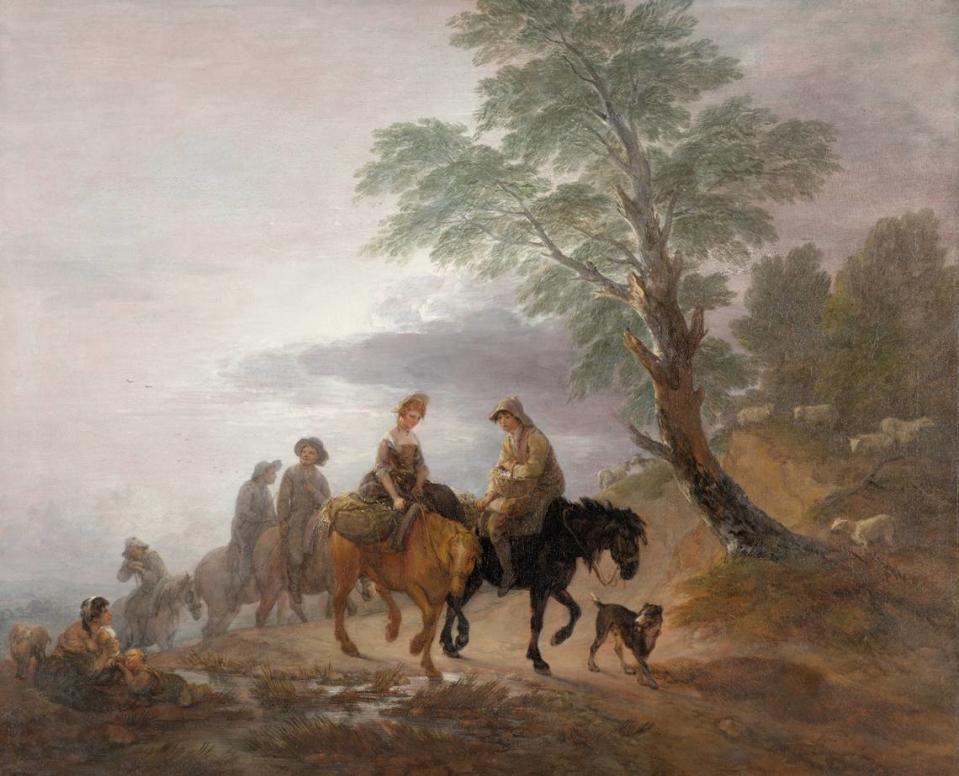Kimbell Museum acquires British masterpiece. Its significance ‘cannot be overstated’
- Oops!Something went wrong.Please try again later.
The Kimbell Art Museum has acquired Thomas Gainsborough’s “Going to Market, Early Morning,” considered one of the finest examples of landscape paintings by one of the 18th century’s most esteemed British artists, the Fort Worth museum announced Thursday.
The Kimbell purchased the painting, circa 1773 and worth an estimated $9 million, through Simon Dickinson, London art dealer. In 2019, a private collector sold the work at Sotheby’s auction house.
The painting had remained in British hands since banker Henry Hoare purchased it in 1773. Until the Kimbell’s acquisition this summer, it left Europe only once, as part of the 2003-04 retrospective Gainsborough at the National Gallery of Art and Museum of Fine Arts, Boston.

The work elevates the museum’s 18th century collection, an area of interest for founders Kay and Velma Kimbell. The Kimbell Art Foundation, the stewards of the museum, acquired “Portrait of a Woman, Possibly of the Lloyd Family” (c. 1750) and another landscape, “Suffolk Landscape” (mid-1750s), in the 1940s. Both are on display next to the work.
Eric Lee, the director of the Kimbell Art Museum, first saw Gainsborough’s “Going to Market, Early Morning” while visiting England in 1987. The Yale University undergraduate studying art history didn’t forget the experience.
“The significance of ‘Going to Market, Early Morning’ cannot be overstated,” Lee said. “Widely published and exceptionally preserved, it has, since its first sale in 1773, been heralded as an exceedingly beautiful work and an important example of a new style of British landscape painting invented by Gainsborough himself.”
Gainsborough was a lifelong resident of England who studied in London and was a founder of the Royal Academy of the Arts. After studying in London, Sudbury and Ipswich, he settled on the tony community of Bath, where he painted this and other portraits.
With his signature swift and light brushstrokes and vibrant palette, he lovingly portrayed the changing British countryside while evoking the styles and stories found in works by the Old Masters, including Titian, Rubens and Jacob van Ruisdael, who heavily influenced his art.
“Going to Market, Early Morning” is no different. In the lyrical and dreamlike setting, five figures on horseback are headed to the market under a silvery early morning sky. Under them is dewy grass and the occasional puddle. Framing them to their right is a tall, mature plum tree leaning inward with ghost-like sheep roaming in the distance. At the bottom left is a woman, believed to be a peasant, sitting on the ground nursing a child and looking up at the travelers. Among those likely catching her eye is one of the travelers, a young woman with glimmering curly auburn hair, holding glistening straws in her saddle bags. Next to her is a young man with a gaping mouth, sitting on the side of his horse, looking at her.
The idyllic portrayal of the British countryside is one of the best examples of the British landscape genre. The painting’s material quality is masterful. But captivating too are the allusions to 17th century figures and stories, elevating it from an everyday scene to a work with depth and complexity.
“It’s fueled by emotion. The mood is wonderful,” Lee said.
When Lee describes a widely published painting, he’s not exaggerating. One Google search yielded 16 pages of citations just from the 20th century. Along with scholarly studies of its enduring influence on painting, the open-ended interpretation of its story intrigues scholars.
“It’s ambiguous. There’s no single reading. You could say the mother looking at them could be the focal point. Or the woman on the horse is dismayed because she is also a peasant,” Lee said.
Given Gainsborough’s stature and the quality and ambiguity of the work, the United Kingdom’s Department for Digital, Culture, Media and Sport initially barred it from leaving the country after its purchase in 2019. In a detailed analysis by an external committee, which reviews potential exports of important artwork, the painting exceeded the criteria for remaining in the country. If a museum could secure the funds, then it got first dibs. It had until at least March 2020, or, at the latest, September of that year.
“Ninety-nine percent of the time the deal goes through,” Lee said.
But when the COVID-19 pandemic hit, the United Kingdom’s economy was hit incredibly hard following lockdown.
An upending the economy worked in the Kimbell’s favor. When the export ban recently expired, the Kimbell purchased the painting.
When it was hung on Monday ahead of the announcement, Lee and his team remarked they could not imagine it elsewhere.
“I can’t imagine the painting anywhere else than at the Kimbell. Its rustic subject matter fits in Fort Worth and the North Texas environment,” he said.
The Kimbell is open from 10 a.m. to 5 p.m. Tuesdays, Wednesdays, Thursdays and Saturdays, from noon to 8 p.m. Fridays and noon to 5 p.m. Sundays. Admission to the Kimbell collection is free. Special exhibitions are $18, $16 for seniors and students and $14 for children 6 to 11.

